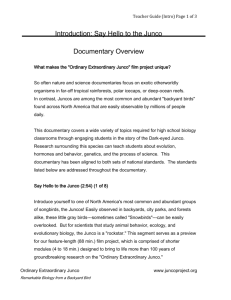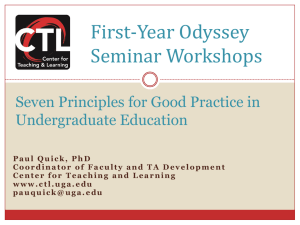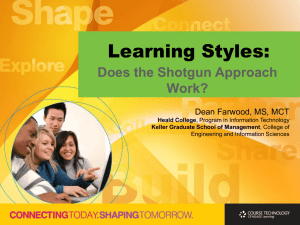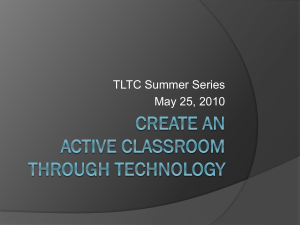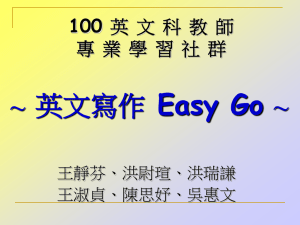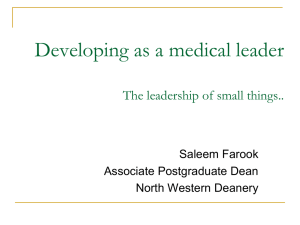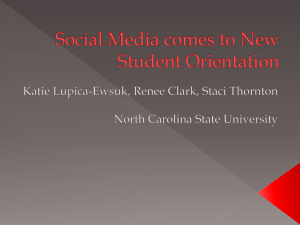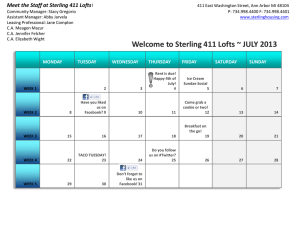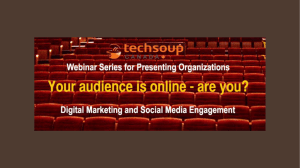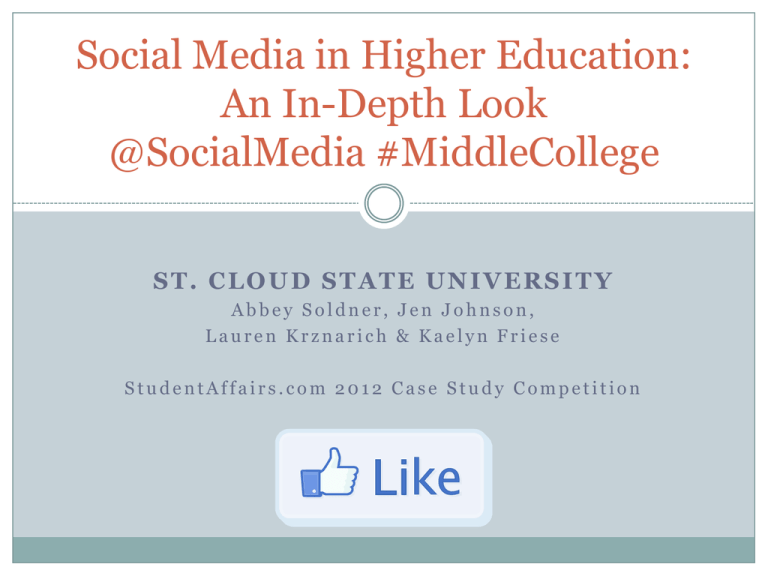
Social Media in Higher Education:
An In-Depth Look
@SocialMedia #MiddleCollege
ST. CLOUD STATE UNIVERSITY
Abbey Soldner, Jen Johnson,
Lauren Krznarich & Kaelyn Friese
StudentAffairs.com 2012 Case Study Competition
Welcome!
Welcome, Middle College Social Media Committee
Members! Our mission today is to educate you on the
cutting edge and effective uses of social media in higher
education, as well as possible concerns, and suggestions
for implementing a social media policy at our college.
Today’s Agenda:
Defining Social Media
Pervasiveness of Social Media
Utilizing Social Media in Higher Education
Applying Theories of Student Development to Social Media: Kolb &
Chickering
Concerns Regarding Social Media
How-To’s for Creating and Implementing a Social Media Policy on
Campus
Socialized to Social Media
Defining the Medium:
“Social Media is a 21st century term used to broadly define a
variety of network tools or technologies that emphasize the
social aspects of the internet as a channel for communication,
collaboration, and creative expression, and is often
interchangeable with the terms Web 2.0 and social software”
(Dabbah & Kitsantas, 2012, p. 3).
“Social media are a collection of websites, services, and
activities that engage users through collaboration, sharing,
and democratization of roles and responsibilities. They
encompass a major shift in focus from the first iteration of the
Web because they allow for increased participation,
connection, and interactivity” (Junco & Chickering, 2010, p.
12).
Social Media At-Large
Image obtained from
http://www.socialmediamagicuniversity.com/
Pervasiveness of Social Media
93 % of adult Internet users in the United States are
on Facebook.
One out of every eight minutes of time spent online
is now spent on Facebook.
The average Facebook user now logs between 11 and
17 hours per month.
There are 70 million WordPress blogs worldwide.
There are 39 million Tumblr blogs worldwide.
4 out of 5 internet users visit social networks and
blogs.
Statistics obtained from Meloy, 2011, p. 16
Pervasiveness of Social Media
On average in one year, each person will share 415
pieces of content on Facebook, will spend about 23
minutes a day on Twitter, tweeting a total of 15,795
tweets, will check in 563 times on Foursquare, upload
196 hours of video on YouTube, and send countless
emails.
Social networking is still the fastest-growing active
social media behavior online, increasing from 36% of
global Internet users to 59% managing their profile on
a monthly basis in 2011.
There are now over 2.8 billion social media profiles,
representing around half of all internet users
worldwide.
Statistics obtained from http://thesocialskinny.com/100-more-social-media-statistics-for-2012/
Image obtained from http://jeffyoung.me/wp-content/uploads/2010/05/social-media-revolution.jpg
Why Social Media?
As seen in the previous slides, social media is exponentially growing at
a rapid rate—in fact, Facebook is the world’s most populated “country”.
Our students have already invaded the world of social media, it is time
for us to jump on board! This will allow us to fully engage and connect
with our students at Middle College.
Image obtained from http://www.pamorama.net/2010/03/03/35-great-social-media-infographics/
Utilizing Social Media in Higher Education
In order to be purposeful and intentional in
implementing social media at Middle College, it is
essential to use student development theory as our
guide.
Kolb and Chickering are two theories which offer
insights that are beneficial in the integration of social
media in higher education.
Now a brief overview of what these two theories
encompass and their relationships with social media.
Kolb’s Model of Experiential Learning
David Kolb examined the different learning styles used by college
students and ways for educators to enhance development through
challenge and support (Evans et al., 2010).
Through research, Kolb identified a four-step cycle of learning:
Concrete
Experience
Active
Experimentation
Reflective
Observation
Abstract
Conceptualization
Kolb’s Model of Experiential Learning
Kolb defined learning as “the process whereby knowledge is
created through the transformation of experience.” (Kolb,
1984, p. 38, as cited in Evans et al., 2010, p. 139)
Concrete experience
Reflective observation
Contemplation of one’s experiences from various perspectives
Observing before making judgments by viewing the environment from
different perspectives
Abstract conceptualization
Full and unbiased involvement in learning experiences
Learning from specific experiences and relating to people
Idea formulation and integration
Logical analysis of ideas and acting on intellectual understanding of a
situation
Active experimentation
Incorporation of new ideas into action
Ability to get things done by influencing people and events through action
Kolb’s Model of Experiential Learning
Through the cycle of learning, Kolb identified four learning styles (Kolb, 1984, as cited in
Evans et al., 2010, p. 140):
Concrete Experience
Feeling
Accommodator
Diverger
• Action oriented, at ease
with people, trial and
error problem solving
• Strengths in carrying
out plans, openness to
new experiences, and
adapting to change
• People and feeling
oriented
• Strengths in
imaginative ability,
awareness of meaning
and values, and
generating and
analyzing alternatives
Reflective Observation
Active Experimentation
Doing
Image obtained from Kolb, 1984,
as cited in Evans et al., 2010, p. 140
Converger
Assimilator
• Prefers technical tasks
over
social/interpersonal
settings
• Strengths in problem
solving, decision
making, and practical
application
• Emphasizes ideas
rather than people
• Strengths in inductive
reasoning, creating
theoretical models, and
integrating
observations
Abstract Conceptualization
Thinking
Watching
Applying Kolb’s Model & Social Media
Kolb’s theory of learning combined with social media
presents many opportunities for student development,
specifically the themes of:
Experiential/Interactive
Learning-Using the world as a classroom
through making meaning of direct experiences to enhance what
students learn in textbooks (Rinaldo, Tapp, & Laverie, 2011).
Self-Regulated/Personal Learning Environments-A pedagogical
approach that utilizes both formal and informal learning (Dabbagh &
Kitsantas, 2011).
Learning-by-doing is considered the most effective
approach to learning. Emerging social media technologies
make it possible to offer students authentic learning
experiences ranging from experimentation to real-world
problem solving.
Applying Kolb’s Model & Social Media
Social media can take students to higher cognitive
processing levels via social interactions both in and out
of the classroom.
Applying
Kolb’s Model to demonstrate how blogs can enhance
students career goals:
Kolb’s
model incorporates experiential learning. Using the world as a
classroom provides students with first-hand experiences that are
applicable to life.
Incorporating a blog into a course provides an avenue for students to
reflect on direct experiences in an environment where students can
share responses and opinions regarding their shared experiences
(Moody, 2010).
Applying Kolb’s Model & Social Media
Applying Kolb’s Model to demonstrate how instructors can
incorporate social media into the classroom to incorporate different
learning styles:
Kolb’s
model lists four learning styles. Incorporating short video clips
to break up class lectures can appeal to divergers and assimilators.
Having students apply learning through discussion posts or
PowerPoints provides convergers and accommodators time for
application and reflection, as well as preparing students for future jobs.
(Moody, 2010)
Applying
Kolb’s Model to demonstrate Twitter’s role in student
involvement:
Kolb’s model involves interaction between the person and the
environment to generate learning.
Twitter can be used to generate interaction in an online course or used
to supplement a face-to-face course (Rinaldo, Tapp, & Laverie, 2011).
Applying Kolb’s Model & Social Media
Implementing Kolb’s Model incorporates both interactive learning for
students to take charge of the learning process, as well as accommodating
different learning styles (Rinaldo, Tapp, & Laverie, 2011).
Concrete Experience
Professor at Middle College introduces a topic in class.
Students can think about the topic and see examples—graphs,
charts, and direct modeling; then they are able to experience
the concrete and tangible. (Evans et al., 2010)
Reflective Observation
Class discussion to generate multiple perspectives and ideas.
Students can look into other sources of information for
increased understanding. (Evans et al., 2010)
Applying Kolb’s Model & Social Media
Abstract Conceptualization
Students use a form of social media to interact with peers and
the course instructor to form their own ideas about the topic.
This will provide students a chance to create their own
learning environments.
Students can tweet responses including different articles or
information to demonstrate understanding; then apply what
they have learned to their own experiences. (Evans et al., 2010)
Active Experimentation
Students actively incorporate learning into their everyday life
through direct experiences. (Evans et al., 2010)
Chickering’s Seven Vectors of Student
Development
Arthur Chickering’s theory details seven vectors of
development that are related to identity formation.
Students experience the vectors throughout their college
experience in multiple situations and contexts.
The
1.
2.
3.
4.
5.
The
seven vectors are:
Developing Competence
6. Developing Purpose
Managing Emotions
7. Developing Integrity
Moving through Autonomy Toward Interdependence
Developing Mature Interpersonal Relationships
Establishing Identity
vectors are not considered to occur in a linear fashion. They are
cyclical in nature and students will often cycle through the different
vectors multiple times and also will likely experience multiple vectors at
the same time. (Evans et al., 2010)
Chickering’s Seven Vectors of Student
Development & Social Media
Vector 1, Developing Competence: Acquiring and
enhancing intellectual, physical and manual skill, and
interpersonal competence
Social
media can help ease the transition and increase connection to
the college by students supporting each other through information
exchange and collaborative learning. Students are able to create
connections before coming to college and sustain connections once they
are on campus. (DeAndrea et al., 2012; Stoller, 2011; Woodley &
Meredith, 2011)
Middle
College could implement a university Facebook group or fan
page for new and current students.
Students can use this platform to create connections with each other
before coming to the college and engage one another by asking questions
and receiving feedback from each other.
The opportunity for student engagement without even stepping foot on
campus brings new opportunities for commuting, out-of-state, and
international students, both before beginning their college career and
after they have arrived.
Chickering’s Seven Vectors of Student
Development & Social Media
Vector 2, Managing Emotions: Ability to recognize,
accept, and appropriately respond to emotions
The
interactions that students engage in via social media allows
them to find other sources of information and assists them in
responding appropriately to their peers. Students are also able to
give each other feedback based on responses they have received.
This exchange will allow students to grow in how they give and
receive feedback and interact with each other. (DeAndrea et al.,
2012; Woodley & Meredith, 2011)
Through
the Facebook page, students can take an active approach
to their education by seeking answers to their questions and
answering each others questions.
Students will learn how to effectively give and receive feedback,
especially when needing to learn how to communicate with those
with differing viewpoints.
Chickering’s Seven Vectors of Student
Development & Social Media
Vector 3, Moving Through Autonomy Toward
Interdependence: Learning to function with relative selfsufficiency; requiring both independence and recognition
of interdependence on others
Students
are already using social media. They are different
from learners in the past in that they take an active approach to
what they do and are considered active learners that expect to be
connected and instantaneously receive information at all times
(Beja, 2009; Ratliff, 2011; Sabado, Gallardo, & Lubach, 2011).
Connecting
with students at Middle College through Facebook meets
them where they are already at developmentally. Our students are active
learners and expect to be connected and receive information
instantaneously at all times.
By meeting our students where they are, we have the opportunity to
help them grow and develop from that point forward.
Chickering’s Seven Vectors of Student
Development & Social Media
Vector 4, Developing Mature Interpersonal Relationships:
Includes both recognizing and appreciating commonalities
and differences of others
Engaging
with other members of the university community
through social media will allow students to interact with many
different people and begin to develop effective ways of
interacting with people that are different from them (DeAndrea
et al., 2012).
Facebook
is essentially about building relationships with those around
you. Beginning to engage with many different students, including
students that have differing viewpoints, will help students start the
process of building mature relationships.
The ability to interact and communicate effectively with those that are
different from yourself is essential in today’s world and having the
experience of connecting via Facebook is one step that can aid in that
process.
Chickering’s Seven Vectors of Student
Development & Social Media
Vector 5, Establishing Identity: Comfort with oneself
in all aspects of identity including appearance, selfconcept, gender, sexual orientation, social/cultural
heritage, and lifestyle roles.
By
having the opportunity to interact with others and to express
their understanding of the world through social media, students
are able to figure out who they are and what is important to them
in various aspects of their life (Woodley & Meredith, 2011).
Facebook
is a place where you could express yourself in any way
that you choose. Our students can begin to figure out what is
important to them and how they want to express themselves through
their interactions with their peers and the college on Facebook.
Chickering’s Seven Vectors of Student
Development & Social Media
Vector 6, Developing Purpose: Establishing
meaningful life commitments, interests, relationships,
and goals
Similar
to establishing identity, the interactions between
members of the university community via social media can help
students discover and solidify their understanding of what they
want in life and what is important to them (Woodley & Meredith,
2011).
Students
at Middle College would have the opportunity through a
Facebook page to enhance and solidify their goals in life and how
they choose to express that to the world. Knowing who you are and
what you stand for is essential for being successful in both personal
and professional aspects of life.
Chickering’s Seven Vectors of Student
Development & Social Media
Vector 7, Developing Integrity: Creating congruence
between personal values and commitments
Social
media can help students figure out who they are inside
and outside of the classroom, and how to bring those two aspects
together. The ability to be congruent in their actions online and
face-to-face will enhance their understanding of themselves.
(Woodley & Meredith, 2011)
Facebook
allows you to present yourself in any way that you choose.
Presenting yourself in a consistent manner both online and face-toface means that you have a clear understanding of your ideals and
goals. Students from Middle College should be able to develop this
consistency through their college experience and establishing who
they are.
Applying Chickering’s Model & Social Media
Using Chickering’s Theory of Development with social media
provides many opportunities for student development
including the themes of:
Peer to Peer Learning
Interactive Learning
Student Engagement
Social media can influence students and their experiences
with the entire university community.
Using social media can help students feel more connected and impact
their views of their overall college experience (Chen, Lambert, & Guidry,
2010).
Engaging through social media often leads to an increased use
of other services, programs, and activities at the university
later on (Olson & Martin, 2010). Middle College has the
opportunity to use online and face-to-face ways of connecting
together in order to engage students in a more effective
manner (Ratliff, 2011).
Concerns Regarding Social Media
While social media offers many effective and exciting
ways to engage students, there are of course
concerns regarding the medium. After reviewing
recent literature, below are common concerns
regarding social media use:
Cyberbullying & Online Harassment
Communication Barriers & Misunderstandings
Privacy Issues
Academic & Personal Development
Quality of Information
Concerns Regarding Social Media
Cyberbullying & Online Harassment
While social media has expanded the potential for human
interaction, it is not always positive.
Cyberbullying is defined as “repeatedly misusing technology to
intimidate, harass, terrorize, or bully others” (Franek, 2006, as cited
in Accordino & Accordino, 2011, p. 15). The consequences of
cyberbullying can be dire.
Social media allows for some anonymity or at least a less threatening
form of confrontation; therefore students are more likely to engage
in cyberbullying and/or harassment than they would in a face-to-face
environment (Junco & Chickering, 2010).
32% of online teenagers have experienced cyberbullying (Pew Internet
& American Life Survey, as cited in Junco & Chickering, 2010).
If bullying is sexual in nature, there is even the possibility of the
student having to register as a sex offender (Cyberbullying Statistics).
Concerns Regarding Social Media
Communication Barriers & Misunderstandings
Through online communication, it is often difficult to identify
the tone of the sender/receiver and nonverbal behavior is not
visible. This often leads to misunderstandings and escalates
situations that may have otherwise been avoidable. (Junco &
Chickering, 2010)
In fact, a Pew-Family Online study revealed that:
25% of teens have had a face-to-face argument/confrontation that
originally stemmed from a social media exchange.
22% of teens claimed to have ended a friendship due to social
media.
Statistics obtained from http://www.dallasnews.com/opinion/editorials/20111229-editorial-teens-andcivility-on-social-media-sites.ece
Concerns Regarding Social Media
Privacy Issues
Often college students assume that their activity and images on
social media sites are “private”, but this is simply not the case.
Social media sites have elaborate service agreements (often
unread by users) that disclose the true level of privacy offered
(Junco & Chickering, 2010). If something is posted on a site, it
will not be leaving the internet anytime soon.
A major concern regarding content uploaded on social media
sites, is the effect it will have on future employment of students.
Middle College prides itself on our job placement rate, so teaching
our students how to effectively manage their information on social
media sites (and potentially use it to their advantage) is imperative.
According to CareerBuilder.com, 45% of employers check out social
media profiles of potential candidates (as cited in Junco &
Chickering, 2010).
Concerns Regarding Social Media
Academic & Personal Development
Studies have shown a “negative association between academic outcomes,
such as GPA, and the use of electronic media” (Jacobsen & Forste, 2011,
p. 275).
Students may spend their spare or leisure time engaging in electronic
media use as opposed to interacting with friends face-to-face; this has
led to negative social outcomes for some students (Jacobsen & Forste,
2011).
Students often form assumptions of their peers based on the information
posted on social media sites; this leads to students forming inaccurate
social norms. A student may feel pressure to engage in higher risk
behaviors based on what they see on social media sites. (Chia & Gunther,
2006)
For example, a student notices that many of the photos on a social media site
are of students drinking and partying; the student then assumes this is the
norm on their campus, even though that may not be the case.
Stereotypes are also more likely to be projected when using electronic
forms of communication due to the ambiguity and anonymity of the
medium (Junco & Chickering, 2010).
Concerns Regarding Social Media
Quality of Information
There is a world of information at our fingertips and it is
available in an instant. However, the quality of information
found online varies greatly.
An enormous amount of information can be obtained in
seconds, but learning how to “sift through the findings and
differentiate between legitimate and bogus” information is the
true challenge our students face (Junco & Chickering, 2010, p.
17).
It is essential that our students learn to think critically, and are
skilled at analyzing and evaluating the information they find
online.
Short How-To’s for Creating a Social Media Policy
After discussing the risks and benefits of social media use, the
following slides offer suggestions for creating and implementing
the Middle College Social Media Policy.
Step 1: Create a taskforce.
The taskforce should be comprised of students, staff, faculty, student
affairs professionals, and administrators who are relatively
technologically savvy and engage in social media regularly. (Junco, 2011)
Step 2: Taskforce given a formal charge from the college.
(Junco, 2011)
Middle College luckily has already been given this charge from our
president. We must examine and implement the following:
Creation of a website where current students can learn not only about the
benefits of using social media in the curriculum and co-curriculum, but
also the challenges.
Information regarding the potential consequences of posting social or
unprofessional comments and images.
Creation of a set of guidelines and consequences for our students
regarding social media use.
Short How-To’s for Creating a Social Media Policy
Step 3: Detailed meeting minutes.
Our minutes should be posted in accessible locations to
students, faculty, and staff to allow for a transparent process.
We should be open to feedback and contributions from people
across campus. (Junco, 2011)
Step 4: A finalized concise, all-encompassing,
accessible, and understandable policy.
This needs to reflect that social media can be beneficial for student
development. By having a clear policy, students will be provided with
freedom to explore their online identity, while also understanding
the expectations of their participation in online communities.
(Junco, 2011)
Social Media Policy Content
The content of our social media policy should include the
following:
Demonstrate that we care about the development of our students and their
experiences with social media in college.
Review other policies currently in place at our college that may also apply to
the social media policy.
Recognize that social media interactions can play an important role in a
student’s development.
Describe privacy limitations and how to protect oneself online.
Explicitly state what we deem unacceptable and accpetable behaviors in
terms of social media use and the consequences for inappropriate use.
Notify students of the resources available at our campus to assist in handling
miscommunications online and conflicts that may arise .
Emphasize that this policy is not only intended for students, but for staff and
faculty as they model this behavior to our students. (Junco, 2011)
Educating Students on Social Media Use
There are several ways to go about educating our
campus community, specifically students, on the
appropriate use of social media.
Have students complete an online education component
regarding the social media policy on our campus and
acceptable usage.
This can be done prior to attending campus or even once they have
arrived. This educational component could provide examples of
the dangers/concerns over social media use and examples of how
to use social media effectively.
Incorporate social media use into first-year seminar courses.
Social media could be a “themed” first-year seminar course or at
least should be incorporated into all first-year courses. Here social
media can be used positively and also educate students on the
dangers.
Educating Students on Social Media Use
Collaborate with Career Services to educate our students on
how social media impacts employment.
Students can be taught how to “clean-up” their social media
pages/sites, so they provide a professional image to employers.
Privacy issues can also be discussed, as well as how to use social
media to their advantage in the job search/employment process.
Collaborate with Residential Life to educate students (and
staff) on how to handle conflicts that have started and/or
escalated due to social media.
Not only could conflict resolution be discussed, but also how to
prevent it from occurring. Students should be made aware of the
lack of context available when communicating online that often
leads to misunderstandings.
Are You On-Board?
This ends our educational session for today. Hopefully
you agree that it is time for Middle College to jump on
the social media bandwagon!
Thank
You!
Image obtained from http://www.wizmarketings.com/social-media-marketing/
References
Accordino, D.B., & Accordino, M. P. (2011). An exploratory study of face-to-face and cyberbullying in
sixth grade students. American Secondary Education, 40(1), 14-30.
Beja, M. (2009, August 24). How students, professors, and colleges are, and should be, using social media. [Web log
comment]. Retrieved from http://chronicle.com/blogs/wiredcampus/how-students-professorscolleges-areshouldbe-using-social-media/7787
Chen, P.D., Lambert, A.D., & Guidry, K.R. (2010). Engaging online learners: The impact of web-based learning
technology on college student engagement. Computers & Education, 54, 1222-1232.
Chia, S., & Gunther, A. (2006). How media contribute to misperceptions of social norms about sex. Mass
Communication & Society, 9, 301-320.
Cyber Bullying Statistics-Bullying Statistics. (n.d.). Bullying Statistics - Teen Violence, Anger, Bullying,
Treatment Options. Retrieved February 18, 2012, from http://www.bullyingstatistics.org/content/cyberbullying-statistics.html
Dabbagh, N., & Kitsantas, A. (2011). Personal learning environments, social media, and self-regulated
learning: A natural formula for connecting formal and informal learning. Internet and Higher Education,
15, 3-8.
DeAndrea, D.C., Ellison, N.B., LaRose, R., Steinfield, C., Fiore, A. (2012). Serious social media: On the use of social
media for improving students’ adjustment to college. Internet and Higher Education, 15, 15-23.
Evans, N.J., Forney, D. S., Guido, F. M., Patton, L. D., & Renn, K. A. (2010). Student development in college:
Theory, research, and practice (2nd ed.). San Francisco, CA: Jossey-Bass.
Fusch, D. (2011). Managing the risks of social media. Higher Ed Impact, n/a, 22-24.
Greysen, R., Kind, T., & Chretien, K. (2010). Online professionalism and the mirror of social media. Journal
of General Internal Medicine, 11(25), 1227-1229.
References
Junco, R. (2011). The need for student social media policies. EDUCAUSE Review, 46(1), 60-61.
Junco, R., & Chickering, A.W. (2010). Civil discourse in the age of social media. About Campus, 15(4), 12-18.
Meloy, A. (2011). Policing the social network. The Presidency, 14(3), 14-17.
Moody, M. (2010). Teaching twitter and beyond: Tips for incorporating social media in traditional courses.
Journal of Magazine & New Media Research, 11 (2), 1-9.
Olson, D., & Martin III, Q. (2010). Engaging college students through online social networks. The Journal of
Technology in Student Affairs, 11. Retrieved from
http://studentaffairs.com/ejournal/Winter_2010/EngagingCollegeStudents.html
Ratliff, A. (2011). Are they listening? Social media on campuses of higher education. The Journal of Technology in
Student Affairs, 14. Retrieved from http://studentaffairs.com/ejournal/Summer_2011/AreTheyListening.html
Sabado, J., Gallardo, I., & Lubach, D. (2011). Social media—New way of doing business [PDF Document].
Retrieved from http://www.sa.ucsb.edu/profdev/Media/ANewWayofDoingBusiness.pdf
Stoller, E. (2011, February 15). Using social media to enhance engagement, yield, and retention. [Web log
comment]. Retrieved from
http://www.insidehighered.com/blogs/student_affairs_and_technology/using_social_media_to_enhance_eng
agement_yield_and_retention
Rinaldo, S.B., Tapp, S., & Laverie, D.A. (2011). Learning by tweeting: Using twitter as a pedagogical tool.
Journal of Marketing Education, 33(2), 193-203.
Woodley, C., & Meredith, C. (2011). Engaging and retaining students—Supporting student transition through
social media [PDF Document]. Retrieved from
http://www.proceedings.com.au/isana/docs/2011/paper_Meredith.pdf

